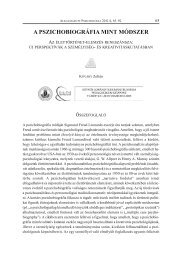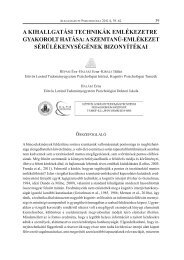letöltése (PDF) - Alkalmazott Pszichológia - Eötvös Loránd ...
letöltése (PDF) - Alkalmazott Pszichológia - Eötvös Loránd ...
letöltése (PDF) - Alkalmazott Pszichológia - Eötvös Loránd ...
Create successful ePaper yourself
Turn your PDF publications into a flip-book with our unique Google optimized e-Paper software.
A nevelési stílus és az érzéketlen/érzelemmentes vonások kapcsolata... 17<br />
BLAIR, R. J. R. (1999): Responsiveness to distress cues in the child with psychopathic<br />
tendencies. Personality and Individual Differences, 27. 135–145.<br />
BLAIR, R. J. R. (2003): Neurobiological basis of psychopathy. Bri tish Jo ur nal of Psychiatry,<br />
182. 5–7.<br />
BLAIR, R. J. R. (2005): The neurobiology of antisocial behavior in psychopathy. In: ALE XAN DER,<br />
E., EMERY, N. J. (ed.): The cognitive neuroscience of social behavior. Psychology Press,<br />
New York. 291–324.<br />
BLAIR, R. J. R., COLLEGDE, E., MITCHELL, D. G. (2001): Somatic markers and response<br />
reverals: Is there orbitofrontal cortex dysfunction in boys with psychopathic tendencies?<br />
Jo ur nal of Abnormal Child Psychology, 29. 6. 499–511.<br />
BLAIR, R. J. R., MITCHELL, D. G. V., BLAIR, K. S. (2005a): The psychopath: Emotion and the<br />
brain. UK: Blackwell, Ox ford.<br />
BLAIR, R. J., BUDHANI, S., COLLEGDE, E., SCOTT, S. (2005b): Deafness to fear in boys with<br />
psychopathic tendencies. Jo ur nal of Child Psychology and Psychiatry, 46. 3. 327–336.<br />
BÖLTE, S., HUBL, D., FEINEIS-MATTHEWS, S., PRVULOVIC, D., DIERKS, T., POUSTHA, F.<br />
(2006): Facial affect recognition training in autism: can we animate the fusiform gyrus?<br />
Behavioral Neuroscience, 120. 211–216.<br />
BRANDT, J. R., KEN NEDY, W. A., PATRICK, C. J., CURTIN, J. J. (1997): Assessment of<br />
psychopathy in a population of incarcerated adolescent offenders. Psychological<br />
Assessment, 9. 429–435.<br />
BURKE, J. D., LOEBER, R., LAHEY, B. B. (2007): Adolescent conduct disorder and interpesonal<br />
callousness as predictors of psychopathy in young adoults. Jo ur nal of Clinical Child<br />
Adolescents Psychology, 36. 3. 334–346.<br />
CHRISTIAN, R. E., FRICK, P. J., HILL, N. L., TYLER, L., FRAZER, D. R. (1997): Psychopathy and<br />
conduct problems in children: Implications for subtyping children with conduct problems.<br />
Jo ur nal of the American Academy of Child and Adolescent Psychiatry, 36. 233–241.<br />
COOKE, D. J., MICHIE, C. (2001): Refining the construct of psychopathy: towards a<br />
hierarchical model. Psychological Assessment, 13. 171–188.<br />
DADDS, M. R., WHITING, C., HAWES, D. J. (2006): Associacions among Cruelty to animals,<br />
family conflict, and psychopathic traits in childhood. Jo ur nal of Interpersonal Violence,<br />
21. 3. 411–429.<br />
DADDS, M. R., PERRY, Y., HAWES, D. J., MERZ, S., RIDDELL, A. C., HAINES, D. J., SOLAK, E.,<br />
ABEYGUNAWARDANE, A. I. (2006): Attention to the eyes and fear-recognition deficits in<br />
child psychopathy. Bri tish Jo ur nal of Psychiatry, 189. 280–281.<br />
DODGE, K. A., LOCHMAN, J. E., HARNISH, J. D., BATES, J. E., PETTIT, G. S. (1997): Reactive<br />
and proactive agression in school children and psychiatrially impaired chronically<br />
assaultive youth. Jo ur nal of Abnormal Psychology, 106. 1. 37–51.<br />
DODGE, K. A., PETTIT, G. S. (2003): A biopsychosocial model of the development of chronic<br />
conduct problems in adolescence. Developmental Psychology, 39. 349–371.<br />
ENEBRINK, P., ANDERSON, H., LANGSTROM, N. (2005): Callous-unemotional traits are<br />
associated with clinical severity in referred boys with conduct problems. Nordic Jo ur nal<br />
of Psychiatry, 59. 431–440.








